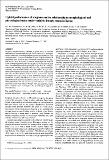Hybrid performance of sorghum and its relationship to morphological and physiological traits under variable drought stress in Kenya

View/
Publication Date
1998-07-01Author
BIG Haussmann, AB Obilana, A Blum, PO Ayiecho, W Schipprack, HH Geiger
Metadata
Show full item recordAbstract/
Sorghum, Sorghum bicolor L. Moench, is grown mostly in semi‐arid climates where unpredictable drought stress constitutes a major production constraint. To investigate hybrid performance at different levels of drought stress, 12 single‐cross hybrids of grain sorghum and their 24 parent lines were grown in eight site‐season combinations in a semi‐arid area of Kenya. In addition, a subset of 20 genotypes was evaluated at the seedling stage under polyethylene glycol (PEG)‐induced drought stress. Environmental means for grain yield ranged from 47 to 584 g/m2reflecting the following situations: two non‐stress, one moderate pre‐flowering, four moderate terminal and one extreme drought stress. Mean hybrid superiority over mid‐parent values was 54% for grain yield and 35% for above‐ground biomass. Across environments, hybrids out‐yielded two local varieties by 12%. Differences in yield potential contributed to grain yield differences in all stress environments. Early anthesis was most important for specific adaptation to extreme drought. Field performance was not related to growth reduction and osmotic adjustment under PEG‐induced drought stress. In conclusion, exploitation of hybrid vigour could improve the productivity of sorghum in semi‐arid areas.
Collections
- Department of Botany [232]
